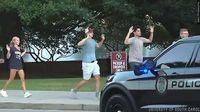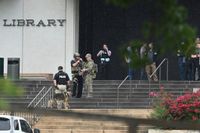As the new academic year kicks off across the United States, a wave of false active shooter reports—known as “swatting” hoaxes—has thrown universities into chaos, sparking panic, lockdowns, and a massive police response on campuses from Pennsylvania to Colorado. The FBI and local law enforcement agencies are scrambling to investigate this unsettling trend, which has left students, faculty, and parents shaken as they return to campus life.
The string of hoaxes began on Thursday, August 21, 2025, when multiple calls flooded law enforcement in Pennsylvania, reporting shots fired on Villanova University’s campus by a man armed with an AR-15 style weapon. According to BBC News, the calls included the sound of gunfire and even claims of wounded victims. The timing couldn’t have been worse—students and their families were gathered for orientation Mass. Suddenly, panic erupted. “Honestly, at that moment I thought, ‘I’m gonna die,’” Villanova student Ava Petrosky told CNN. She joined the rush for cover as chairs scattered and students hid in closets. The campus went into lockdown, only for the all-clear to be given two hours later after authorities determined it was all a cruel hoax.
That same day, Tennessee authorities received calls about an active shooter at the University of Tennessee at Chattanooga, again citing an AR-15 and multiple victims. Senior Luke Robbins described the chaos to the Chattanooga Times Free Press: “In two seconds, the whole classroom evacuated. Run outside, there’s cops with ARs in the hallways, and they’re like, ‘Hey, go up this way,’ so we get out. Run across the street. There’s even more cops telling us to go. I mean, it was just hectic. It’s crazy.”
The hoaxes didn’t stop there. In the days that followed, campuses in Iowa, Arkansas, Arizona, Kansas, New Hampshire, South Carolina, Louisiana, and Colorado found themselves under siege by similar false reports. On Monday, August 25, 2025, the University of Colorado Boulder was placed in a three-hour lockdown after a hoax call about shots fired at Norlin Library. Police later confirmed there was no threat and launched an investigation, treating the case as swatting, according to BNO News.
By Tuesday, August 26, the disruption had spread further. West Virginia University’s downtown campus received a false active shooter report, prompting a thorough search by the Monongalia County Sheriff’s Office. Sheriff Todd Forbes confirmed that no evidence of a threat was found and the area was declared secure. Around midday, University of Kentucky Police and Lexington Police responded to a similar hoax near William T. Young Library. Officers used campus security cameras to quickly determine there was no threat, and no alerts were issued. Central Georgia Technical College also fell victim to a false call about an active shooter at its Macon campus. The school initially advised students to shelter in place, but the advisory was lifted after law enforcement cleared the campus.
These incidents have not been isolated. At least 14 universities have been targeted by similar hoax calls in recent days, with reports stretching from New Hampshire to Arizona and from South Carolina to Pennsylvania, according to BNO News and the Associated Press. The calls often share a disturbing pattern: multiple calls to authorities, sounds of gunfire in the background, and claims of casualties. In some cases, like the University of South Carolina on Sunday, August 24, 2025, the library was the focus of the false alarm, with two separate calls reporting an active shooter and gunshots.
Law enforcement officials say the goal of swatting is to provoke a heavy police response, often involving SWAT teams. The FBI, which created a database in 2023 to track such threats, is now working closely with local police to identify the source of the calls. “We are aware of recent swatting incidents involving a number of colleges and universities and are working with our law enforcement partners,” the FBI told BBC News. The agency warned that each false report “drains law enforcement resources, costs thousands of dollars, and, most importantly, puts innocent people at risk.”
The emotional toll of these hoaxes is significant. Students and staff have described moments of genuine terror. Miceala Morano, a senior at the University of Arkansas, hid behind a green screen in the broadcast room and called her grandmother as officers outside donned bullet proof vests. “As of right now, I’m safe. I love you,” she told her grandmother, recalling the active shooter drills she’d practiced since childhood. Her classmate, Casey Mann, said she couldn’t sleep until 2 a.m. after the incident. “It’s just a scary reality the time we’re living in right now,” she admitted, her voice choked with emotion.
Experts warn that the repeated false alarms risk creating a dangerous sense of complacency. Mya Norman, a chemistry instructor at Arkansas, expressed concern that students might begin to dismiss real alerts. “It does make me worry that people will be inclined to think it’s a false alarm,” she said. “We live in tornado alley where people hear a tornado warning and go outside to look. So it does concern me that we could end up with that kind of an effect.” Ken Trump, president of National School Safety and Security Services, echoed the need for balance: “It’s that delicate balance, not downplaying an active shooter because those things are occurring but also we don’t want people to go to work paranoid and panicked every day.”
While no arrests have been made in connection with the recent spate of hoax calls as of August 26, 2025, the FBI notes that several individuals have been jailed in previous swatting cases. These include a man extradited from Romania, a Wisconsin man who hacked doorbell cameras to livestream police raids, and a 19-year-old American-Israeli teen convicted of making thousands of threats to Jewish institutions worldwide. The agency stresses the seriousness of these crimes, pointing to past incidents where police, responding to a hoax, have accidentally shot—sometimes fatally—innocent people. In 2017, a man in Wichita, Kansas, was killed by police after a swatting call, a tragic reminder of the real-world consequences of these fake threats.
The FBI is urging the public to remain vigilant and to report anything suspicious immediately to law enforcement. As the investigation continues, universities are left grappling with how to keep students safe without fostering an atmosphere of constant fear. For now, campuses across the country remain on edge, hoping that the perpetrators of these disruptive and dangerous hoaxes will soon be brought to justice.
In a time when mass shootings are a grim reality, the line between real and fake threats has never felt thinner. For students and educators, every alarm—real or not—comes with a jolt of fear, a scramble for safety, and a lingering question: what will it take to stop the next one?

